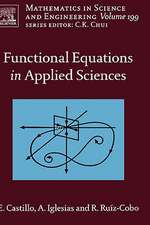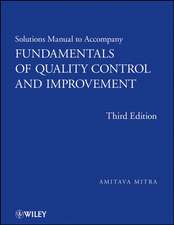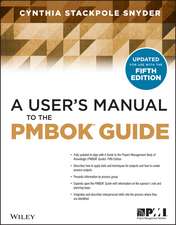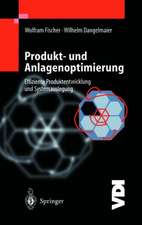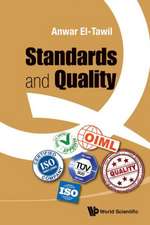A Unified Statistical Methodology for Modeling Fatigue Damage
Autor Enrique Castillo, Alfonso Fernandez-Cantelien Limba Engleză Hardback – 23 feb 2009
| Toate formatele și edițiile | Preț | Express |
|---|---|---|
| Paperback (1) | 638.11 lei 6-8 săpt. | |
| SPRINGER NETHERLANDS – 19 oct 2010 | 638.11 lei 6-8 săpt. | |
| Hardback (1) | 644.30 lei 6-8 săpt. | |
| SPRINGER NETHERLANDS – 23 feb 2009 | 644.30 lei 6-8 săpt. |
Preț: 644.30 lei
Preț vechi: 758.01 lei
-15% Nou
Puncte Express: 966
Preț estimativ în valută:
123.28€ • 129.07$ • 102.01£
123.28€ • 129.07$ • 102.01£
Carte tipărită la comandă
Livrare economică 05-19 aprilie
Preluare comenzi: 021 569.72.76
Specificații
ISBN-13: 9781402091810
ISBN-10: 1402091818
Pagini: 248
Ilustrații: XIV, 232 p.
Dimensiuni: 155 x 235 x 24 mm
Greutate: 0.53 kg
Ediția:2009
Editura: SPRINGER NETHERLANDS
Colecția Springer
Locul publicării:Dordrecht, Netherlands
ISBN-10: 1402091818
Pagini: 248
Ilustrații: XIV, 232 p.
Dimensiuni: 155 x 235 x 24 mm
Greutate: 0.53 kg
Ediția:2009
Editura: SPRINGER NETHERLANDS
Colecția Springer
Locul publicării:Dordrecht, Netherlands
Public țintă
Professional/practitionerCuprins
and Motivation of the Fatigue Problem.- Presentation of the Book. An Integrated Overview of the Fatigue Problem.- Models Used in the Stress Based Approach.- S-N or Wöhler Field Models.- Length Effect.- Models Used in the Strain Based Approach.- Log-Weibull ?-N Model.- Models Used in the Fracture Mechanics Approach.- Crack Growth Models.- Damage and Damage Accumulation Models.- Damage Measures.- Damage Accumulation.
Recenzii
From the reviews:
"This book provides a unified methodology to derive models for fatigue life. … The book gives a new methodology to build-up fatigue models based on a practical knowledge of fatigue problems, combined with common sense, functional equations and statistical methods. … Appendix presents a short description of classical and more recent fatigue models existing in the literature. The proposed models allow simple approaches to be implemented in a practical fatigue design, similar to those employed in current engineering standards." (Razvan Raducanu, Zentralblatt MATH, Vol. 1161, 2009)
"This book provides a unified methodology to derive models for fatigue life. … The book gives a new methodology to build-up fatigue models based on a practical knowledge of fatigue problems, combined with common sense, functional equations and statistical methods. … Appendix presents a short description of classical and more recent fatigue models existing in the literature. The proposed models allow simple approaches to be implemented in a practical fatigue design, similar to those employed in current engineering standards." (Razvan Raducanu, Zentralblatt MATH, Vol. 1161, 2009)
Textul de pe ultima copertă
This book aims to provide a unified methodology to derive models for fatigue life prediction. This includes S-N, e-N and crack propagation models. This book is unique in that it contemplates the three main fatigue approaches (stress-based, strain-based and fracture mechanics) from a novel and integrated point of view. As an alternative to the preferential attention paid to deterministic models based on the physical, phenomenological and empirical description of fatigue, their probabilistic nature is emphasized in this book, in which stochastic fatigue and crack growth models are presented.
After an introductory chapter in which an overview of the book is provided, the following chapters are devoted to derive models for the S-N fields for fixed and varying stress level, the e-N fields, the relations between the two, and an analysis of the size effect in fatigue problems. Next, crack grow models are derived based on fracture mechanics, statistical and common sense considerations, which lead to functional equations providing non-arbitrary models. Two different approaches are given, leading to two classes of models, the intersection class of which is derived through compatibility analysis. Then the compatibility of the S-N curves model and the crack growth model, which are two aspects of the same fatigue problem, are used to obtain a model which allows both approaches to be connected. Finally, the problem of selection damage measures is analyzed, and some damage measures are proposed as the most convenient, including the probability of failure and a normalized measure related to the percentile curve. This leads to very simple and useful damage accumulation models, which are illustrated with some examples.
The book ends with an appendix with a short description of some classical and some more recent fatigue models of those existing in the literature.
After an introductory chapter in which an overview of the book is provided, the following chapters are devoted to derive models for the S-N fields for fixed and varying stress level, the e-N fields, the relations between the two, and an analysis of the size effect in fatigue problems. Next, crack grow models are derived based on fracture mechanics, statistical and common sense considerations, which lead to functional equations providing non-arbitrary models. Two different approaches are given, leading to two classes of models, the intersection class of which is derived through compatibility analysis. Then the compatibility of the S-N curves model and the crack growth model, which are two aspects of the same fatigue problem, are used to obtain a model which allows both approaches to be connected. Finally, the problem of selection damage measures is analyzed, and some damage measures are proposed as the most convenient, including the probability of failure and a normalized measure related to the percentile curve. This leads to very simple and useful damage accumulation models, which are illustrated with some examples.
The book ends with an appendix with a short description of some classical and some more recent fatigue models of those existing in the literature.
Caracteristici
brings together state of the art in the field, and presents a unified approach of the subject Includes supplementary material: sn.pub/extras



